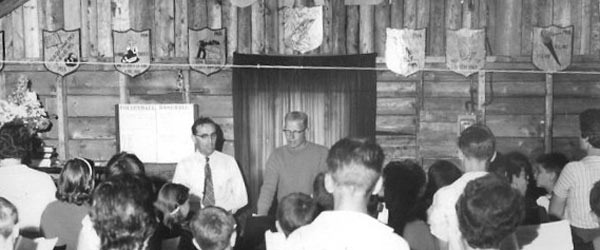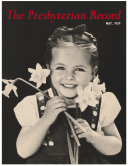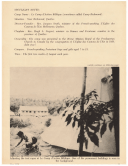
History
The Early Years of Camp d’action biblique
Based on the account of Mrs. Yvette (Perron) Larochelle
1947
It all started with a dream; the dream of a man who had a vision and a great deal of love for children and young people, and a desire to make known to them the love and providence of God. His name was Reverend Jacques A. Smith, and his dream was to found a summer Bible camp where children could get close to God’s creation and to the Creator Himself. This would be a place where they could admire God’s handiwork and learn to praise His name in all the truth and with the faith that youth possess.
The year was 1947, and having recently arrived in the Richmond area from Montreal, Rev. J. A. Smith was holding French Presbyterian church services in the home (a big rambling country house) of Mr. and Mrs. Paul J. Perron on Craig Road near what was originally known as Richmond Hill. He got to personally know several French families in the vicinity of Richmond, Melbourne, Windsor, Danville, Asbestos and St. Paul de Chester and discovered that they had numerous children! He spoke rather enthusiastically to the parents, explaining the joys and the Biblical learnings, activities and advantages of camp life from which they could benefit. As parents agreed to let their children experience camp life, Rev. Smith’s dream was about to become reality.
The first camp in 1947 was held in a field on the farm of Mr. Gerald Fortier with about nine children. They slept in two small tents and Rev. Smith in his car. The children awoke each morning to the loud horn of the car. They would trudge each day from the campsite down to the church for their meals prepared by Mrs. Beatrice Rodgers. One day, upon their return to the campsite, they discovered that visitors had come while they were absent. Gerald Fortier’s cows had ravaged the tents, dispersed their belongings, and left a few “souvenirs” everywhere. Rev. Smith, the wise man that he was, quickly turned everything into a big joke and, by his side, put the children to work and after several hours the camp was functioning again. This was the first unexpected experience of camp life. They learned that disappointments, as well as joy and happiness, were a part of life.
1948-1949
The following two years of camp were held at Mr. Philippe Perron’s sugar bush on the old Valley Road in Richmond. Rev. Smith borrowed several large army tents which could accommodate 20 children and they slept contented under the stars until one night a heavy rain storm, followed with thunder and lightning, made the children scream with fright as rain leaked in the tents and soaked their beds and faces. Luckily, Mr. Perron had a little cabin close by, where the cooks, Mrs. Philippe Perron and Mrs. Laterreur, slept. The tables were pushed aside and makeshift beds were made. A fire was lit in the stove and clothes were hung everywhere to dry as the campers slept in lawn chairs and on the floor. After several hours of hard work, things finally quieted down. Comforted, the younger children cuddled together tucked under warm blankets as the counselors, cooks and minister enjoyed a hot cup of coffee before lying down for a much-needed rest after an eventful night. The remainder of the week was without mishap and enjoyed by all.
During the first three years, Rev. Smith was unfailing in his search for a permanent campsite. One day after talking to Mr. Paul Perron about his dream, he was informed that the place he was looking for might possibly be on M. Perron’s own property! Rev. Smith asked, “Is there a brook?” The answer was affirmative; a small brook, fed by pure spring water, flowed through the property. Naturally, Rev. Smith lost no time and asked to be taken to this place and discovered that the site had much potential. Rev. Smith projected his vision on the surroundings. He envisioned building a dining hall and kitchen in one spot, a chapel in another, the minister’s quarters and First Aid building next to the dining hall and cabins for campers would be arranged in a semi-circular formation around a clearing on the edge of the woods.
1952
In 1952, on a piece of land nestled in a picturesque forest and situated on a babbling brook, a camp was constructed by the willing hands of the congregation of l’Église des Cantons-de-l’Est (which was later renamed Église St-Paul). The camp was baptized « Camp d’action biblique », which in English means Bible Action Camp.
Rev. Smith bought a house in the nearby village of Flodden, which he donated to the camp. The house was dismantled, transported and rebuilt by volunteers from the congregation on the camp property to serve as a dining hall and kitchen. He then donated his own personal garage which would be converted into a cabin.
This new camp property was in part a gift to the church by M. and Mme. Paul Perron. The church bought an additional piece of land from M. Perron a few years later to meet the camp’s growing needs. Five additional cabins were built in the following years with the help of funds from the Presbyterian Board of Missions.
1959
In 1959, to the delight of all campers, a concrete dam was built to retain the waters of the brook and form a beautiful little lake. Until then, the campers relied on Gerald Fortier who took them on a hay wagon drawn by his tractor or truck to the lake at Denison Mills every day after his milk run for their daily swim. The dam at camp was built with the help of a Government subsidy and a giant bulldozer and backhoe accomplished the job. Much of the groundwork for this project was accomplished by Mr. Roland Perron. The land was cleared of trees, the stumps removed, the ground leveled, and the wood split for firewood to heat the camp. Nights were cold, mornings were damp, and the dining hall and large kitchen wood stove needed constant refilling to cook meals for some 60 children. A portion of land was leveled, ploughed and sowed with grass and clover to create a playing field where softball, races and other games could be held. Following the government grant for the construction of the dam, the camp had to comply with government standards, which meant that several existing outhouses had to be condemned and replaced with flush toilets. A new building was built according to government standards.
The next major project was a lovely little white chapel to be nestled under tall spruce trees. A church originally built by the Église Saint-Paul congregation in St-René-de-Beauce was dismantled and transported to Richmond where it was reassembled by the local congregation on the camp site, where it would stand until 1984 untiln it was moved to a new location on the camp property.
To show their appreciation of Rev. Smith and other camp leaders for their Christian teaching and joy experienced during the weeks spent each summer under their leadership, campers typed and compiled a book with all the camp songs that they were taught. This was later copied and used every summer by the French camps as their official song book. The early years of Camp d’action biblique also had an important influence in nurturing future Christian leaders. An early example is that of John Fortier, eldest son of Mr. and Mrs. Gerald Fortier of Melbourne, Quebec. John Fortier was ordained as minister in May 1960.
After buildings were erected from 1952 to 1960 they needed to be equipped. Dishes, utensils and other needs for the kitchen and cooks were donated from local cupboards. A donation received from Mrs. Doyan, a personal friend of the Smiths, was also helpful. The local W.A. group made dozens of dish towels out of white sugar bags and each family donated a quilt and wool blanket. As there still was not enough to equip the growing camp, blankets were borrowed for the campers. After camp, these blankets were divided among the local women in equal shares to be washed. A very generous couple from the congregation, Mr. and Mrs. Godfrey Malboeuf, made and donated two heavy quilts each winter until the camp had enough.
Every summer Rev. Smith welcomed between nine and fifteen needy children from the small missions that he had established in St-René-de-Beauce, Cap-de-la-Madeleine and Église St-Luc in Montreal for one or two weeks at camp. He received grants for these children; however, the money wasn’t sufficient to cover all costs incurred for a week at camp. Early in the morning, Rev. Smith would make the rounds and pick up produce spared from local gardens to help feed all these hungry campers. Volunteer cooks generously gave of their time to prepare this food. From 1949 until 1967, Mrs. Philippe Perron, Mrs. La Terreur, Mrs. Lucille Vidal, Mrs. Rachel Gifford, Mrs. Aurore Menard and Mrs. Real Larochelle were a few of the original cooks who spent much of their holidays and vacations volunteering in the kitchen at camp.
Others used their various talents to repair doors and windows, paint buildings and contribute to other major projects like the rebuilding of a roof that collapsed following heavy snow one winter. An important donation of bunk beds was received from a French Protestant school in Pointe-aux-Trembles when it closed its doors. Mattresses and several folding chairs were also donated from the Feller Institute. Gerald Perron played an important part in obtaining these donations as he was a student at this school in his youth and a member of Le Fonds du Pret d’Honneur de l’Institut Français Évangelique de la Pointe-aux-Trembles.


Read the Presbyterian Record article from May 1959
1963
After 14 years of service, in 1963 Rev. Smith left the local congregation for a position in Montreal. His successor, Rev. Gerald Doran arrived in 1966 and continued the work begun by Rev. Smith. From 1963 until 1966 the congregation of Eglise St-Paul continued upholding the camp, managing rentals and necessary repairs. This endeavor was a lot of work for a small congregation and a special meeting was called to discuss the future of the camp and the congregation’s involvement in its upkeep. It was decided that the camp would be offered to the Presbytery of Québec for Christian education of youth. Under the guidance of Rev. Doran, the camp was offered to the Presbytery free of charge and taxes. Conditions were drawn up and the camp was presented to the Presbytery during a special ceremony held on camp property in 1967. Considering the challenges and hard work involved in building a camp, it was with pride and mixed emotions that the congregation presented the camp to the Presbytery of Québec.
In loving memory of Mme Yvette (Perron) Larochelle (died April 2000), Reverend Jacques A. Smith (died June 2001) and Jeanne Larochelle (died November 2003)

